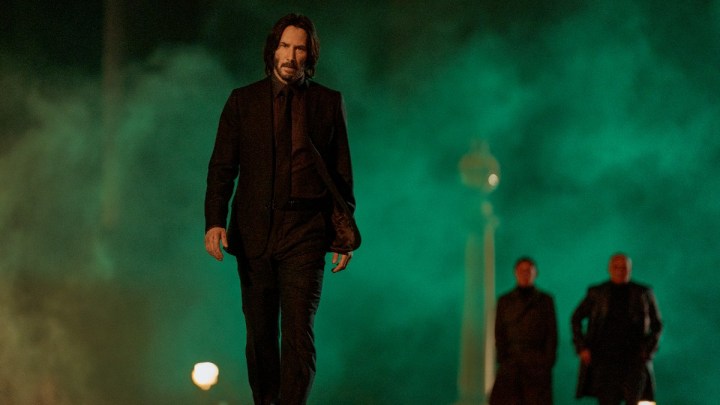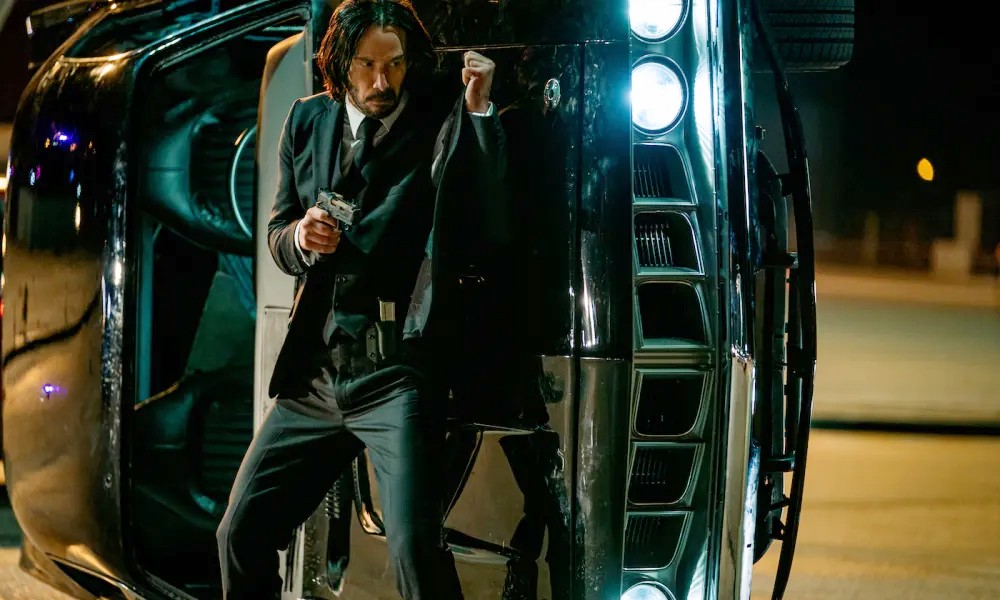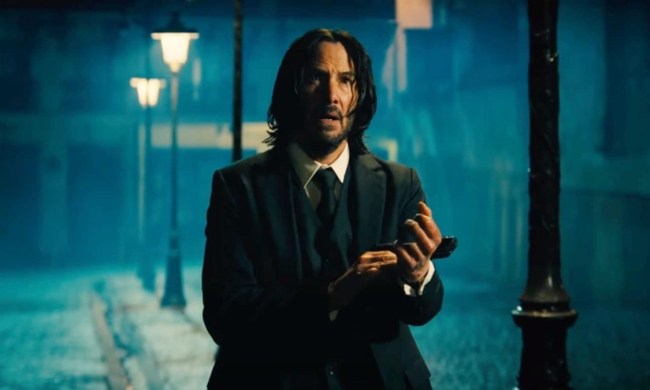
“John Wick: Chapter 4 has some of the best action scenes ever made, but its bloated 169 minute runtime ultimately ruins the overall experience.”
- Features some of the best action scenes ever
- Great cast of returning and new actors
- Lean, cohesive story
- It's just too damn long
- Fight scenes overstay their welcome
There’s no franchise more scrappy and likable than the John Wick movies of the last decade. The first film, 2014’s John Wick, was a low-budget affair, helmed by an unproven director, stuntman Chad Stahelski, and starring a then-unbankable Keanu Reeves. The movie did OK in theaters but found a more appreciative fanbase on home video.
John Wick: Chapter 2 and John Wick: Chapter 3 – Parabellum added to the growing Wick mythos, upping the action quotient, adding more stars (Halle Berry! Laurence Fishburne! Even Angelica Huston got into the mix.), and becoming more successful commercially and critically with each release. It’s been four years since the last movie, and the love and appreciation for the franchise have only increased since then.
With John Wick: Chapter 4, the series reaches its apex point and gives you exactly what you want: more action, more death-defying stunts, more exotic locales, more murders that bend the rules of biology and physics, more sad Keanu, more, more, more. That’s the chief pleasure of Wick number four, and its fatal flaw. At 169 minutes, it eventually wears out its welcome, even if it still impresses with some of the best action choreography Hollywood can produce.
The same old John Wick (and that’s a good thing)

John Wick: Chapter 4‘s plot doesn’t deviate too much from its predecessors: John gets involved with the shady High Table, the Bowery King (Laurence Fishburne, cool as ever) helps him out, and lots of bad guys get slaughtered in very creative ways. This time around, John runs up against the Marquis Vincent de Gramont (Bill Skarsgård, who makes for a fine dandy villain), a high-ranking member of the High Table who wants John dead.
Hunted once again, John seeks shelter at the Osaka Continental, where his old friend Shimazu Koji (Hiroyuki Sanada) and daughter Akira (the singer Rina Sawayama, good but underused) hide John before the inevitable fight between Koji’s army and Gramont’s henchman. During this battle, John meets two new characters: Mr. Nobody (Shamier Anderson, appropriately mysterious), a bounty hunter whose only allegiance is to who has the most money; and Caine (Donnie Yen, a good addition to the series), another old friend of Wick’s who is now working for Gramont.
After escaping Osaka, Wick meets up with Winston Scott, who we last saw shoot John off an NYC rooftop in Chapter 3. (It seems John got better.) Scott suggests the only way to defeat Gramont is to play by the High Table’s rules. In other words, he needs to challenge Gramont to a duel, and whoever wins, lives. For this duel to occur, John needs to become a member of a crime family once again, travel to Berlin, and shoot, stab, and crash into countless hordes of bad guys across famous Paris landmarks like the Arc de Triomphe and the Basilica of Sacré Coeur de Montmartre.
The plot’s pretty simple, and that’s a good thing for a third sequel in a franchise like this one. Except for a scene with the Elder at the beginning that ties up a dangling plot thread from the previous film, John Wick: Chapter 4 is fairly self-contained and coherent, something that is lacking in today’s moviegoing landscape of needlessly complicated cinematic universes, multiverses, and reboots disguised as sequels.
John Wick: Chapter 4 has some of the best action scenes ever

Chapter 4‘s greatest strength, and major weakness, is its action scenes, which are some of the most complex and intricate that have ever been put on film. The siege at the Osaka Continental hotel, for instance, showcases Stahelski’s talent for marrying tension and action into an extended fight scene that pivots from aggressive (Koji and Akira’s army brutally take down Gramont’s henchman in the crowded hotel lobby) to restrained (John takes on Caine in one-on-one combat) seamlessly.
More impressive is the extended action scene in Paris, which finds John battling pretty much every bounty hunter in the world on the streets of Montmartre, inside abandoned apartment buildings, in rush hour traffic in front of the Arc de Triomphe, and on the famous 222 steps leading to the Sacré-Cœur. On paper, this really shouldn’t work, yet Stahelski does this by making the transitions from each scene seem logical. The director even stops and pulls a De Palma, inserting a long overhead shot in a Montmartre building to give the audience a bird’s eye view of the action, which is both self-indulgent and completely necessary to the narrative. There’s an elegance to some of the action here that borders on poetry, and is worthy of comparison to such legendary movies in the genre like Terminator 2: Judgment Day and Mad Max: Fury Road.
Is too much of a good thing bad?

Stahelski’s only mistake, and it’s a big one, is to linger too much on the action scenes, which not only dilutes their effectiveness but exposes the strained reality that the John Wick universe now finds itself in. For instance, the fight sequence in the Berlin nightclub begins well enough, with John, Caine, Mr. Nobody, and new character Killa (an unrecognizable Scott Adkins) playing a tense game card game before battling in a crowded nightclub, which has an indoor waterfall primarily to set the stage for fight scenes like this one. As the sequence goes on, Stahelski begins to repeat himself; John kills a bad guy with a gun, then an axe, then kills some more the same way, etc. Meanwhile, the ravers in the nightclub don’t react at all to the bloodshed around them, highlighting the fantastical world John Wick operates in, where virtually everyone on the street is a hitman just waiting to be called upon.
It’s a far cry from the first John Wick, which grounded its hero in a pain that made him instantly a protagonist you could root for. The action in the original, and even in the more elaborate sequels, made some kind of sense, even when they were outrageous. In Chapter 4, they are just outrageous, and while they are impressive, they are also too long and too numbing to be as effective as they could be. When John ascends those 222 steps toward the end of the film and then is pushed down to the bottom to start all over again, the effect is one more of exasperation than anything else. Must we go through all that again? That’s a question I asked a lot throughout Chapter 4‘s nearly three-hour runtime. There are only so many ways John can kill someone before it becomes too repetitive and, well, dull, and that’s fatal for any action film.
Highs and lows
John Wick: Chapter 4 is a frustrating movie to sit through because there’s a great two-hour action movie in there surrounded by 49 minutes of bloat. I wouldn’t cut a single action sequence in the movie as each has its own form and function that serves the narrative and adds to John’s story; instead, I’d cut down each one just a bit, make the action leaner and meaner, and not linger too much on the absurdity of the hyper-realized world that John Wick operates in. [Seriously, does anyone blink twice at shootouts in crowded city streets or old-fashioned duels at popular tourist destinations?]
Whenever I see a John Wick movie in a theatre, I compare it to riding a rollercoaster. The ride is short but dizzying, with just enough highs and lows to keep you satisfied. John Wick: Chapter 4 is like riding a rollercoaster for three hours. It’s fun at first, but at some point, you just want to get off the ride and eat a hot dog.
John Wick: Chapter 4 is now playing in theaters. For John Wick fans, read John Wick: Chapter 4’s ending explained, John Wick: Chapter 4’s best scene, 5 reasons why John Wick is the best action movie ever, 5 things we want to see in John Wick: Chapter 5, and does John Wick die at the end of John Wick: Chapter 4?



